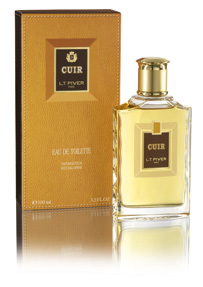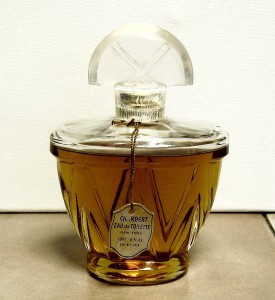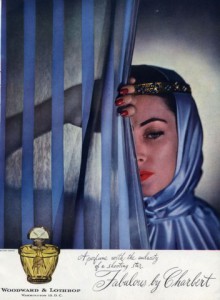L.T. Piver – Cuir
 While not well-known in the United States, the French L.T.Piver house has been producing fine fragrances for over two centuries. The firm dates its origins back to the court of Louis XVI and has continued through the to the twenty-first century, adapting many of its traditional fragrances to a modern sensibility. Similar to the houses of Lubin and Guerlain, L.T. Piver became an official purveyor to the royal court of Louis XVI and later expanded to the other royal families of Europe.
While not well-known in the United States, the French L.T.Piver house has been producing fine fragrances for over two centuries. The firm dates its origins back to the court of Louis XVI and has continued through the to the twenty-first century, adapting many of its traditional fragrances to a modern sensibility. Similar to the houses of Lubin and Guerlain, L.T. Piver became an official purveyor to the royal court of Louis XVI and later expanded to the other royal families of Europe.
The firm is named for Louis Toussaint Piver who began the Piver legacy, and helped propel it to international acclaim in England, Belgium, Spain, Austria, Russia and Brazil. L.T. Piver maintained a flower-processing factory in Grasse, plus a second facility in Aubervilliers dedicated to the manufacture of cosmetic products, of which L.T. Piver created a prodigious range. Similar to Guerlain, the firm commissioned special edition bottles from Baccarat and Lalique, which would be destined to become collector’s items.
This review is for the modern Cuir produced as an Eau de Toilette by L.T. Piver. The fragrance was  originally created at the end of the nineteenth century under the Cuir de Russie moniker, consistent with that era’s fascination with Russian culture. This manufacture date makes L.T. Piver’s creation a contemporary of Guerlain’s Cuir de Russie, and indeed, the two share certain similarities. Both feature a stronger, smokier birch tar smell than either the Chanel or Lubin Cuirs, giving the fragrance a more rustic feel. The strength of their smell characters also feels decidedly more masculine, although the Guerlain Cuir softens to a floral heart in the drydown, while the L.T. Piver maintains a fairly homogenous character throughout its wear. The modern L.T. Piver Cuir is marketed to a male audience, so the emphasis on the strong birch tar aspect without a softer, floral counterpoint seems intentional, but gives the fragrance a somewhat one-dimensional aspect when compared to the Guerlain.
originally created at the end of the nineteenth century under the Cuir de Russie moniker, consistent with that era’s fascination with Russian culture. This manufacture date makes L.T. Piver’s creation a contemporary of Guerlain’s Cuir de Russie, and indeed, the two share certain similarities. Both feature a stronger, smokier birch tar smell than either the Chanel or Lubin Cuirs, giving the fragrance a more rustic feel. The strength of their smell characters also feels decidedly more masculine, although the Guerlain Cuir softens to a floral heart in the drydown, while the L.T. Piver maintains a fairly homogenous character throughout its wear. The modern L.T. Piver Cuir is marketed to a male audience, so the emphasis on the strong birch tar aspect without a softer, floral counterpoint seems intentional, but gives the fragrance a somewhat one-dimensional aspect when compared to the Guerlain.
Cuir’s opening features a bright citrus accord of mandarin and bergamot, which serve to lighten the fragrance somewhat and create a sense of refreshment. As the smoky birch tar unfolds, I detect the spicy notes of clove and cinnamon, giving the fragrance a rich feeling, one that makes it suitable for autumn or winter use. At the heart of Cuir is a hint of soapiness, and here is where the fragrance begins to soften somewhat. At its base, Cuir features a touch of woods and oakmoss, sweetened by a honey-like note, which I imagine to be the coumarin making its presence felt.
While Cuir does possess a distinct character that makes it a natural choice for a man, this is definitely a fragrance that can be carried off well by a woman who is not afraid of bracing leathers. The fragrance is fairly tenacious, lasting well throughout the day without fading excessively. The sillage, while potent, is never offensive with careful application, though I would not suggest more than 2 sprays of the fragrance.
Notes: Bergamot, mandarin, leather, woods, spices and honey





